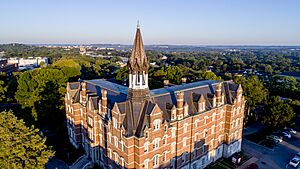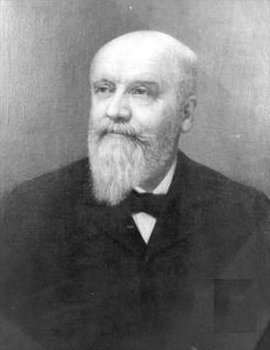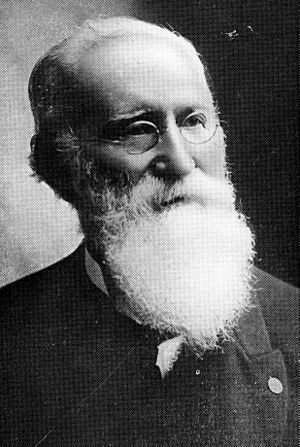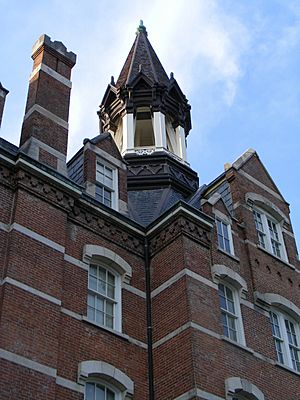Fisk University facts for kids

Jubilee Hall
|
|
|
Former names
|
The Fisk Freed Colored School (1866–1867) |
|---|---|
| Motto | "Her sons and daughters are ever on the altar" |
| Type | Private historically black liberal arts college |
| Established | 1866 |
|
Religious affiliation
|
United Church of Christ (historically related) |
|
Academic affiliations
|
UNCF ORAU CIC |
| President | Agenia Walker Clark |
|
Academic staff
|
70 full-time |
| Students | 1,055 (fall 2022) |
| Location |
,
U.S.
36°10′08″N 86°48′17″W / 36.1688°N 86.8047°W |
| Campus | Urban, 40 acres (16 ha) |
| Language | English |
| Colors | Gold and blue |
| Nickname | Bulldogs |
|
Sporting affiliations
|
NAIA – HBCUAC |
| Mascot | The Fisk Bulldog |
Fisk University is a private college in Nashville, Tennessee, United States. It is a historically black college (HBCU). This means it was founded to educate African American students.
Fisk University started in 1866. Its campus is 40 acres big and is a special historic place. In 1930, Fisk was the first historically black college to be officially recognized by a major education group. It is also the oldest college in Nashville.
Contents
History of Fisk University

How Fisk University Began
Fisk Free Colored School opened on January 9, 1866. This was right after the Civil War ended. It was created to educate formerly enslaved people in Nashville.
The school was founded by John Ogden, Erastus Milo Cravath, and Edward Parmelee Smith. They were part of the American Missionary Association. This group helped start many schools in the South for freed slaves.
The school is named after Clinton B. Fisk. He was a Union general who helped get money for the school. He also found a place for the school in an old army building.
Fisk University in the 1800s
Many people wanted to learn, so 900 students joined the school very quickly. Students of all ages, from seven to 70, attended.
In 1867, the school changed its name to Fisk University. It began to focus on higher education. James Dallas Burrus, John Houston Burrus, Virginia E. Walker, and America W. Robinson were the first students to enroll. In 1875, the Burruses and Walker were the first African Americans to graduate from a liberal arts college in the Southern United States.
In 1870, Adam K. Spence became the school's principal. He wanted to move the school to a bigger campus. To raise money, his wife, Catherine Mackie Spence, helped organize fundraising efforts.
Adam Spence also supported starting a student choir. This choir became the famous Fisk Jubilee Singers.
The Fisk Jubilee Singers
The school needed money, so the choir went on tour in 1871. They traveled across the U.S. and Europe. They sang for important people like Ulysses S. Grant, Mark Twain, and Queen Victoria. They helped make spiritual songs like "Swing Low, Sweet Chariot" popular.
Their tours raised a lot of money, about $50,000. This money helped build Jubilee Hall. It was the first building made for the education of freed people in the South. Today, it is a National Historic Landmark.
In 1875, Fisk co-founder Cravath became the university's first president. He helped build more buildings and added more subjects to study. By the early 1900s, Fisk was known for its strong education.
Fisk University in the 1900s
Fisk University focused on a liberal arts education. This means students learned a wide range of subjects. In 1910, the school started a social science department. It was the first place to train African American graduate students in social work.
From 1915 to 1925, Fayette Avery McKenzie was president. He helped Fisk become a top college for Black students. He also helped Fisk get academic recognition from important groups. He raised $1 million to make sure the teachers were excellent.
In 1930, Fisk became the first historically black college to be officially recognized by the Southern Association of Colleges and Schools. This was a big step for the university.
In 1946, Charles S. Johnson became Fisk's first African American president. He was a famous sociologist. He expanded the school's Institute of Race Relations. This institute studied racial differences and helped create plans for desegregation.
In 1952, Fisk was the first mostly Black college to get a Phi Beta Kappa charter. This is a very old and respected academic honor society in the U.S.
Fisk University and the Civil Rights Movement
In 1960, Fisk students joined other Black leaders in the Nashville sit-ins. These were peaceful protests against segregation at lunch counters in Nashville. Martin Luther King Jr. spoke at Fisk in May 1960.
Fisk students John Lewis and Diane Nash were important leaders in these protests. Nashville became the first major city in the South to end segregation at lunch counters. Lewis and Nash also became early leaders of the national Student Nonviolent Coordinating Committee (SNCC).
In 1978, Fisk's campus was named a National Historic Landmark. The campus was greatly restored in the 1990s with help from the U.S. government.
Fisk University in the 2000s
From 2004 to 2013, Hazel O'Leary was Fisk's president. She was the second woman to lead Fisk. She had also been the U.S. Secretary of Energy.
In 2018, Fisk was placed on probation by its accrediting body. This was due to financial concerns. However, Fisk worked hard to raise money and increase student enrollment. In 2020, Fisk was taken off probation and kept its accreditation.
Fisk University Campus
|
Fisk University Historic District
|
|
| Location | Roughly bounded by 16th and 18th Aves., Hermosa, Herman and Jefferson Sts. Nashville, Tennessee |
|---|---|
| Architectural style | Italianate; Queen Anne |
| NRHP reference No. | 78002579 |
| Added to NRHP | February 9, 1978 |
Fisk's 40-acre campus was officially opened in 1876. It is on a small hill about two miles northwest of downtown Nashville. This area was once Fort Gillem, a Union army fort during the Civil War. The campus is on Jefferson Street, a historic center for Nashville's African American community.
The Fisk University Historic District was added to the National Register of Historic Places in 1978. Many important buildings on campus are part of this historic district:
- The Carl Van Vechten Gallery was built in 1888. It used to be the school's gym. Now it is an art gallery. It holds Fisk's famous Stieglitz Collection of modern art.
- Carnegie Hall was built in 1908 as a library. It was the first major building designed by Moses McKissack III. He co-founded the first African American-owned architecture firm in the U.S.
- Cravath Hall was finished in 1930. It is named after Fisk's first president, Erastus Milo Cravath. This eight-story building was originally a library. It has murals by painter Aaron Douglas. These murals show the history of Black people in the Americas. The building now holds administrative offices.
- Fisk Memorial Chapel was built in 1892. It is in the Victorian style. At the time, it was the largest building for African Americans to gather in the country. The chapel is used for school events, concerts, and graduations.
- Jubilee Hall was completed in 1876. It is the oldest permanent building for the higher education of African Americans in the U.S. It is named for the Fisk Jubilee Singers. They toured to raise money to build it.
- Talley Brady Hall was built in 1931. It was the first modern chemistry building at a historically black college. It is named after two important African American chemists and faculty members, Thomas E. Talley and St. Elmo Brady.
Other buildings on the register include Little Theater, Harris Music Building, and several student homes. In the 1930s, the Olmsted Brothers firm helped design the campus landscape.
Images for kids
Art and Literature at Fisk University
Library Collections
Fisk has a special collection of music literature. It was started by Carl Van Vechten, a famous figure from the Harlem Renaissance. The campus museum is named after him. Fisk also has many items related to writer Charles W. Chestnutt.
Aaron Douglas Murals
Harlem Renaissance painter Aaron Douglas created murals for Cravath Hall in 1930. He said they showed "a panorama of the development of Black people in this hemisphere." Douglas later taught art at Fisk and led the art department. The murals were restored in 2003.
Alfred Stieglitz Art Collection
In 1949, Georgia O'Keeffe gave Fisk University a collection of paintings. These paintings belonged to her late husband, Alfred Stieglitz. He was a famous photographer and art supporter.
The collection has 101 artworks by important artists. These include European modern artists like Paul Cézanne and Pablo Picasso. It also includes American artists like Marsden Hartley and works by O'Keeffe herself.
For a while, Fisk faced financial problems. The university decided to share the collection with the Crystal Bridges Museum of American Art. Now, the two museums take turns showing the artworks every two years. Fisk University still owns the collection. In 2016, the collection was shown at the newly renovated Carl Van Vechten Gallery.
Science Programs at Fisk University
Fisk University has a great history of academic success. It has helped more African Americans earn PhDs in science than any other college.
Fisk-Vanderbilt Bridge Program
The Fisk-Vanderbilt bridge program started in 2004. It helps students from underrepresented groups get into PhD programs in science, technology, engineering, and math (STEM). This program is a partnership between Fisk and a larger research university, Vanderbilt. It aims to bring more diverse students into doctoral studies.
The program offers scholarships for a master's degree at Fisk. It also provides strong support for students who go on to get a PhD. Since 2004, many students have completed their PhDs through this program. The program has a very high success rate.
Fisk University Rankings
| USNWR Liberal Arts College | 171–221 |
|---|---|
| Washington Monthly Liberal Arts | 199 |
| Forbes | 642 |
- For 2021, U.S. News & World Report ranked Fisk University tenth among 79 historically black colleges and universities in the U.S.
- It was also ranked among the top schools for "Most Innovative Schools" and "Top Performers on Social Mobility."
- Washington Monthly ranked Fisk 199th among liberal arts colleges in 2020. This ranking looks at how colleges help the public good.
- Forbes ranked Fisk 642nd on its 2019 list of "America's Top Colleges."
Fisk University Athletics
Fisk's sports teams are called the Bulldogs. They are part of the National Association of Intercollegiate Athletics (NAIA). They mostly play in the HBCU Athletic Conference (HBCUAC).
Fisk has 14 different sports teams. Men's sports include basketball, cross country, golf, soccer, and track and field. Women's sports include basketball, cross country, golf, gymnastics, tennis, track and field, and volleyball. In 2022, Fisk became the first HBCU to have a competitive women's gymnastics team. However, this program will end after the 2025-2026 season due to financial reasons.
Notable Alumni
Notable Faculty
| Name | Department | Notability | Reference |
|---|---|---|---|
| Camille Akeju | Art | Art historian and museum administrator | |
| Arna Bontemps | Librarian | Head librarian and Harlem Renaissance poet | |
| Miriam Eliza Carey | Librarian | teacher | |
| Aaron Douglas | Art | Harlem Renaissance painter, illustrator, and muralist | |
| Robert Hayden | United States Poet Laureate (1976–1978) | ||
| Charles Spurgeon Johnson | President, Research | First African-American president of Fisk University | |
| James Weldon Johnson | Literature | Author, poet, and civil rights activist; wrote the poem on which the song "Lift Ev'ry Voice and Sing" is based (also known as the Black national anthem) | |
| Percy Lavon Julian | Chemistry | Chemist and second African-American member of the National Academy of Sciences | |
| Anne Gamble Kennedy | Music | Concert pianist, piano professor, and accompanist for the Fisk Jubilee Singers | |
| Matthew Kennedy | Music | Concert pianist, piano professor, and director of the Fisk Jubilee Singers (1957–1986 intermittently) | |
| John Oliver Killens | Writer in Residence | Two-time Pulitzer Prize nominee | |
| Lee Lorch | Mathematics | Mathematician and civil rights activist. Fired in 1955 for refusing to testify before the House Un-American Activities Committee. | |
| Hazel R. O'Leary | President | First woman and first African-American U.S. Secretary of Energy; fourteenth president of Fisk University | |
| Helen Clarissa Morgan | Latin | First woman to be appointed professor of Latin (1869–1907) at a coeducational college | |
| Robert E. Park | Sociology | Sociologist of the Chicago School | |
| Jessie Carney Smith | Librarian | Head librarian and scholar | |
| John W. Work III | Music | Choir director, ethnomusicologist, and scholar of Afro-American folk music |











